Dr. Hallett is a recent alumnus (SNRE PhD ’17), working with the support of the Jacksonville Zoo, Z4, the UN, UF, and USAID in Guyana.
Work
What is your research about?

Courtesy of Google Earth
My dissertation research was about jaguars. We used camera traps to help determine factors driving their distribution and abundance across time and space. The part of Guyana where I work has both natural neotropical savannah and tropical rainforest, with a transition zone in between. We were trying to understand, first, how jaguars and their prey are using that space, the open savannah, and the forest fragments and creeks within it. Jaguars are known as the iconic rainforest species, but they use a variety of habitats, and we were trying to understand how they use that mosaic of habitat types.
We’re starting now, and building over time, to layer human activities on top of that, so we can understand the impacts of logging activity, or the presence of livestock, or hunting activity. Things like that might change how and when animals use space.
When did you know you wanted to work in ecology? Is there an origin story?
It was really when I got to undergrad, which I know is late compared to other people. I always enjoyed being outdoors as a hobby. I was into sports, but also liked camping and fishing, birdwatching, and spending time outdoors, in general.
I was always interested in environmental issues, too. When I went into undergrad, I thought policy was the way to change things. I actually started out as a political science major.
It wasn’t until I took some ecology classes for my biology minor that I realized that I could make a living by understanding and asking questions about the natural world, and be in the field.
That was really when the light went on for me.
In particular, I had an outdoor zoology lab. I went to the College of Charleston, in South Carolina. They had an outdoor space on an old plantation owned by the college. It was kind of like the WIS 4945C Wildlife Techniques course offered by WEC. We were out doing amphibian surveys, mist netting for birds, and using all kinds of traps and camera traps. That was where I first got the opportunity, tools, and understanding to ask and try to answer all these ecological questions that I’d thought about over time. It really got me excited!
What’s one word that describes how you work?
Collaboratively. Even though I do the camera trapping work, which is hard data and a major part of my dissertation, the project itself was meant to be a collaboration between myself and the indigenous communities and private landowners I was working with in Guyana.
The camera trapping work focused on a big ecological question, but it also provided space to empower people to learn about science and ask questions about resource use and change in their environment. When you talk to indigenous people in Guyana, first of all, there are no climate deniers. People know what they see, they know what they experience, and they have an intricate understanding of what’s happening with climate patterns and how the land and the animals are responding.
They live a subsistence lifestyle, so they depend on the landscape for their livelihood. Introducing technology and the scientific methodology gave people a new way to understand their environment, and to answer questions and direct the decisions that they make.
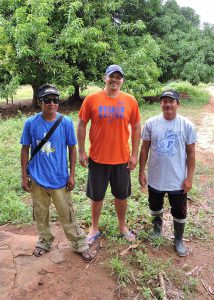
Indigenous communities are trying to adapt and catch up, especially in Guyana where the infrastructure isn’t great. A lot of people are starting to experience capitalism and global culture for the first time in the last decade. Access to things, and exchanging money for items, was much less common twenty years ago. So there are a lot of rapid social changes in addition to the climate and environmental changes going on. I think science and research provide an avenue for people to adapt and preserve their traditional livelihoods and sustainable management in a lot of ways.
What’s your favorite organism you’ve studied and why?
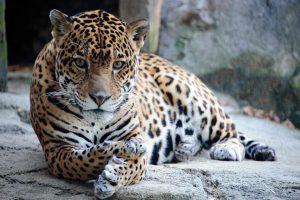
I feel compelled to say the jaguar. It continues to be my favorite, even though I’ve been pursuing it now for many years and I’ve only seen one a few times.
I think that’s why it’s my favorite. As soon as you turn on a camera trap in the field in Guyana, jaguars are out doing their thing. We’ve seen courtship behavior on camera traps, we’ve seen predation behavior on camera traps, and we’ve seen females with cubs and maternal care, so the animals are there and in healthy densities, from what we can understand.
The amazing part is that you never see them with your eyes. They are so well evolved to that environment, that if they don’t want you to see them, you don’t get to see them. I’ve been working in Guyana for eight years now, and I’ve only seen jaguars maybe four or five times.
Most of those have just been a split second, like one running across the road while I was working. I had one particularly good sighting early on, where we saw a large male resting along a river bank. I got to watch him for about five or ten minutes. It was one of those experiences that really affects you.
It’s really their secretive nature, their stealth and power, and the fact that they’re so amazingly adapted to their environment that make them my favorite organism.
What’s an unexpected experience you’ve had because of your work?
Lifestyle
How do you manage your time?
Time management is one of the biggest challenges for me.
My fiancé is a very organized, timely person, and I’ve never been that way. Growing up, your parents and coaches always want you to be on time, and with school you’re on a very specific schedule.
When I started working in Guyana, where people are on this very relaxed, Caribbean time, I joked that when I went there, I found my place!
It’s a place where people have a less rigid perception of time management, because things move slowly and are more nebulous. It fits the style that I already had, whether mine was born out of sheer laziness or disorganization (laughs)!
I’ve tried to get better at time management. My biggest focus is on efficiency. When I was working on my dissertation, I wanted to make time for myself and my family and to get away from work.
To do this, I would pick periods where I would shut everything off, so I wouldn’t be distracted by Facebook, or Instagram, or TV, and focus on work. If I’m efficient with that time, I won’t feel bad in my personal time, and I won’t fall behind.
It helped me reduce my own stress and the stress in my relationships. It also helped me be a better student, and a generally happier person.
When I commit to working, I only work. When I hit a roadblock, and don’t know what to write or think, I go for a walk until inspiration comes back, then shut everything off again, and use that inspiration to see it through without distraction.
How do you balance long periods in the field with your personal life?
The field is where I love to be, not that I don’t love being home, in Gainesville and at UF, but I am a fieldwork junkie.
I have yet to get tired of setting camera traps. I look through all the photos myself, and I still like doing it.
There are red-rumped agouti, which is a 30 pound rodent that is very common in Guyana. I’ve seen BILLIONS of pictures of them at this point, and I still get a kick out of the photos.

I think part of the key is that my fiancé and I are both very independent-minded people, and we like having our own time in addition to being together, so we’ve always had an understanding that this is the work I do.
We appreciate the time we have together, and the time we’re apart.
When I first went to Guyana eight years ago, communication was really limited. It would be weeks or a month before I could get a message out to my parents or friends.
It’s helped that the communication has improved a lot, so internet access and cell phone signal are making thier way across the region. I can get a call in places that I couldn’t before.
I try to be honest with everyone that the field is where I love to be. It’s where I’m happy, and the most motivated, doing the work I want to be doing.
I think once people see that you’re doing what you’re passionate about, they respect it, even if it’s out of the norm like spending months in South America instead of at home.
What do you do for fun?
In addition to outdoor activities like hiking and camping, I love sports. I’m from Chicago, so I’m a big Chicago sports fan. I watch and play sports whenever I can. I was always into intramural sports here at UF. I was pleasantly surprised about that, because there weren’t as many intramural sports available where I did my master’s and I was feeling the need to be more active.
I have fun doing anything that gets me moving. I think my brain and legs are directly attached. Whenever I can’t think, or I’m stuck on a problem, getting moving helps me.
I like hiking and camping, playing sports, and taking the dog for a walk.
What do you like about living in Gainesville?
It’s a funky town! I really like it here.
When I moved here, I wasn’t expecting to become a long-term Florida resident, that wasn’t in the “grand plan”. All I really knew about Florida was Disney World.
I think it’s everything you want in a college town, but downtown also has a good city feel. There’s music all the time, culture, good food, everything you could want, and you’re not too far from the beach or the swamp.
The springs have blown my mind. Someone told me about Crystal River when I was in Charleston, and we drove down for a weekend, so I’d seen the springs and the manatees, but I didn’t have a concept of how many there are and how amazing they are.
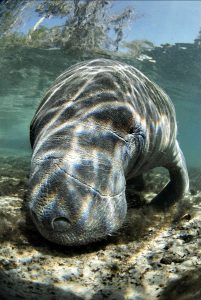
So, in addition to the town itself having a lot of cool stuff going on, you’re in close proximity to a lot of great natural areas.
There are so many, too. After living here for five years, I’m still constantly hearing about new state parks, or city parks, or springs that I haven’t been to. It’s been a pleasant surprise, and made Gainesville more like home: a place I’d like to stay.
Have you got any wildlife jokes?
Well, people in the interior of Guyana have a really good and strong sense of humor, but almost all their jokes are really dirty, so maybe not appropriate for an interview!
They have traditional stories there too, which are often funny, so I’ll forward you one to include.
The story:
Courtesy of Pantanî
In the old days, there were times were this monkey would find himself in strong disagreement with other animals, especially the jaguars. The latter’s dislike for the monkey had developed precisely because the monkey was so clever and smart at doing things. This did not please the jaguars; they felt that they should be the masters of the forest.
So the jaguar family started conspiring against the monkey. They planned to kill him at any length and efforts it would take. Their first idea was to call upon the monkey to check the grandfather jaguar who would pretend to be in serious illness.
The monkey was lying on the low hanging branch of a white tree, which was full of fruits. He had just finished eating some sweet juicy fruits and was relaxing. Suddenly, a young female jaguar arrived in haste. “Quick, monkey!” she said, “my grandfather is very very ill, and he looks like he will not be able to live much longer unless you help him. I am here kindly asking you to come and check him.”
Not only was the monkey clever and smart, but he was also very knowledgeable of forest products and medication for illnesses which were rarely known by the rest of the animals. Notwithstanding the hurriedness of the jaguar, the monkey quickly scanned his memory on the status of the grandfather jaguar and he thought right away that this could be a trap. He responded the jaguar “is he really really sick?” “He is very sick!” responded the female jaguar.
The monkey consented to go and look at the grandfather. They both agreed that they would meet at the grandfather’s place. The monkey jumped from tree to tree, and branch to branch while the female jaguar travelled on the ground level. Upon arrival at the home of the jaguars, the monkey assessed the scene from the tree. He noticed that the grandfather was placed in the center, lying on freshly laid grass and surrounded by the younger and strong jaguars.
The monkey instantly saw the threat and understood that the sudden illness of the elderly jaguar was probably an attempt to capture him. So he devised a plan to verify the sickness of the jaguar while coming down the tree. When the jaguar family saw the monkey approaching, they started rejoicing. As he stepped a little closer to the grandfather, one of the young jaguars welcomed him and said they were happy that he came to his rescue.
“So, family”, said the monkey, stopping at a fair distance. “Is he really sick?” he asked. And every member of the family assented. The monkey went on “well, we have to see how serious this is. I remember, when my grandfather was very sick and dying, he would release some very loud farts with groaning-like sounds before dying…” Hearing this, the elder jaguar released one of the loudest farts that the monkey ever heard and started moaning and groaning.
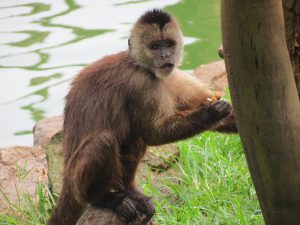
“Indeed, he seems very sick”, said the monkey. But he knew. Because the sick jaguar had responded to him by farting and moaning and groaning meant that he was not sick and that he had better run and save himself.
“I need to go back to get my medication” the monkey explained, adding that he would return soon. Unaware of his plan, the jaguars agreed and urged him to return as quickly as possible.
The monkey hopped on a branch and disappeared. He never returned.
As they realized they had been tricked, the jaguars planned a new trap. It was about a week after the first attempt and they hadn’t seen the monkey since. It was also a time where the whole land was going dry, with all the creeks and shallow ponds drying up. The jaguars decided to wait for the creeks to completely dry up until the only water point left was a deep pool. They waited for that deep pool to shrink in size and the whole family sat and waited in a circle around it, leaving just about enough space between them to allow other animals to pass through and get a drink.
Knowing that he was in trouble, the monkey checked all the other possible places where he could find water but, to his dismay, there wasn’t any. The only water source was a great distance away and it would take him too much time to get there. So, once again, he started thinking in search for a clever idea. “I know how!” he said to himself. “I know exactly how to pass those greedy animals.”
The monkey went to the closest wild honeybees’ hive he could find, where fresh honey could be found. “I do not want to disturb you”, he said to the bees. “I just need to use some of your honey.” He gently ripped a piece of the hive and, with the fresh honey running, he rugged it against his body. The monkey then headed back towards the water pool and, as he was getting closer, he looked for the driest spot on the forest floor, where lots of dry leaves of different colors could be found. He then rolled himself in the leaves over and over again until his sticky fur was totally covered.
Soon, the jaguars’ attention was attracted by some noise coming from the forest and they prepared themselves for the arrival of the monkey. But the creature they saw was not the monkey. In fact, they weren’t sure what it was so they sat there and observed it with curiosity as it passed through their ranks and turned around to face them. In a hoarse and low growling voice, the creature said that he was the master of the forest and all the things living within it. The jaguars got really afraid, but they did not move.
Realizing that his trick was working, the monkey proceeded towards the pool and drank loads of fresh water, which settled painfully in his tummy. And after a few minutes of drinking and resting, he returned and passed the jaguars, who were still unsure of what to do. And as he had reached a safe distance and was close to a tree, the monkey rolled on the earth and shook himself free of the dry leaves. When they understood that the creature had always been the monkey, the jaguars quickly plunged in his direction but it was too late. From a safe height in the tree, the monkey railed the jaguars and told them that he would never ever be trapped or killed by any one of them and disappeared again.
What are you currently reading?
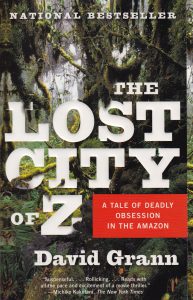
The Lost City of Z by David Grann. It’s really good!
I like historical period, nonfiction books about early explorers. My bookshelf and kindle are full of books about Teddy Roosevelt and John Muir in the US, Dr. Stanley and Livingston in Africa, Alfred Russel Wallace. Anything I can get my hands on, even old diaries.
I think, when I first went to Guyana, I was expecting that kind of experience, like being the first person to explore some area. You work up that kind of romantic picture in your head.
The funny thing about Guyana is that, even though large parts are mostly uninhabited, there are signs of people all through the forest.
You’ll go way into the forest, and think that you must be the first person to ever set foot in an area, only to find an old farm site or rubber trees that had been tapped historically.
The forests of Guyana may not all have permanent human residents, but they have been used by people for the entirety of human history in the area, and managed very well by those people.
It’s really flipped for me. Guyana is about 85% forested. It has the second highest forest cover in the world. Surinam is the highest, and it borders Guyana, so there are these large tracts of forest.
At first I thought that this was because nobody lives there, and people weren’t using it, but I’ve come to realize that the forests in that part of the world aren’t there in spite of the people, they’re there because of the people who have lived there for such a long time, and because of how good a job they’ve done managing those systems and using resources in a sustainable way.
It’s not that the forests have somehow survived human inhabitance, they’re thriving because of the choices made by the people who live there.
In Closing
If you could call yourself back when you started undergrad, what advice would you give?

Take more math classes!
I think the statistics and math are always the biggest challenge for me. The way we learn, especially math, is so linear. You learn the basic skills and understanding, then build on top of it.
I think that early undergrad and high school is when you get that basic understanding of the principles of math and its disciplines. So, if I could talk to myself, I’d tell myself to pay more attention. Really invest in learning why things are the way they are, how to make decisions, and which statistical tests to apply to different data. Because now when I struggle, it’s not because I’m having a hard time learning a particular new thing, it’s because somewhere along the line I didn’t fully understand the basis upon which all this was built.
I would tell myself to learn the material past what’s necessary to get the right answer on an exam, and to really understand why that’s the right answer.
What did you do for your master’s?
I did two master’s degrees, both at Miami University in Ohio. The first was a Master of Arts, and it was a hybrid online and field study program.
When I got out of undergrad, I was working as an educator in zoos and aquariums. They have an organization within the Miami University called Project Dragonfly, which has a part time master’s program for educators. You do coursework online, and you do some field studies in the summer time. They have courses in about twelve or fifteen countries, so I was lucky enough to travel around and learn.
During that time I was sort of in flux. I would bounce between field and education jobs, and wasn’t really sure where I wanted to go.
Being in a global field program with Project Dragonfly made me realize that I wanted to do research and conservation in the field.
I went back for a second master’s to do a thesis. That was my master’s in environmental science, and it allowed me to do my first full research project from start to finish.
I did that project in Guyana, camera trapping jaguars. My PhD dissertation grew out of that.
Who else would you like to see answer these questions?
I’ll say Brittany Bankovich (WEC MS ’14), my fiancé. I’ll throw her under the bus, especially since she works for FWC right on the other side of town!
Is there anything else you’d like to tell people?
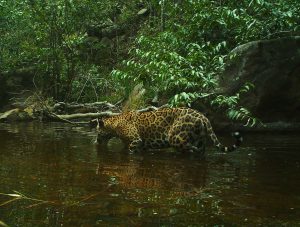
Go follow them for more pictures and information!
Follow us on social media!
We’re not an organization, just a virtual group right now, but our team is called the Rupununi Wildlife Research Unit.
We try to post as many updates as we can, and we have a team managing the page and running projects!
Facebook is the most popular social media in Guyana. People use it, not just for information, but to communicate. Especially in the interior, if I need to get in touch with someone, I can email them until my fingers fall off, but if I message them, I’ll usually get a quick response.
During my dissertation, we worked with twelve communities, four private ranches, and two protected areas. We started it with the idea that if Community A checks their cameras and finds a picture of a jaguar or something of interest, they can post it, and Community B can say “Oh, cool! We got a picture of an ocelot on ours!”
They can keep in touch in that way.
Since then, we’ve gotten a pretty big following in Guyana, especially on the coast where most of the people live, so we try to include environmental and conservation related news from Guyana and the region, and conservation resources that are available.
If people are interested in reading some of that, learning about Guyana, and seeing highlights of what we’re getting from the field, check us out!
This interview by Rhett Barker, and lightly edited for clarity by Rhett Barker and Claire Williams.
Thanks to Dr. Matt Hallett for sitting down with us!
Learn more about the UF/IFAS Department of Wildlife Ecology and Conservation here!
Follow Dr. Hallett and his colleagues on Facebook here!
The concept for this interview is based on an interview series by the University of Washington called How UW Works, which is in turn based on a series called How I Work by LifeHacker magazine.
 0
0
